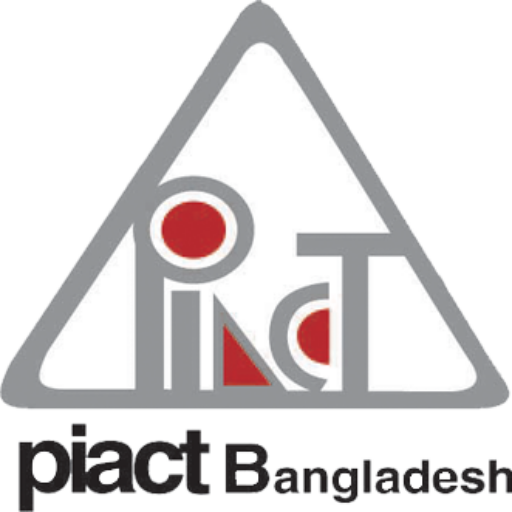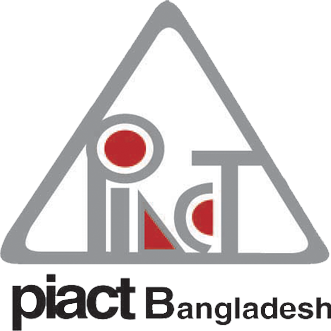Empowering Lives,
Transforming Communities
PIACT Bangladesh was established in 1980 with the objective to empower the poor, illiterates, people deprived from mainstream opportunities and socially excluded groups to enjoy basic human and social rights and improved livelihood. Basic human rights of sex workers were established to protect from oppression and exploitation. Sex workers children were integrated into the society through providing education, capacity building, job placement and social marriage. Ultra-poor students were sensitized to avail education incentive and unemployed disadvantaged youths were mobilized to avail skills training and job placement opportunities of the government.
ked with the skills training and social resources for improved livelihood. Developed capacity of school children to say NO to drug and resist peer pressure for substances abuse. HIV and AIDS information were integrated into the curriculum to mainstream of education from grade VI to XII. Teachers were trained to teach HIV in the classroom effectively.
Programs
The agencies who were working in the area of mother and child nutrition in mid-eighties strongly felt the need for educational support materials on mother and child nutrition for the fieldworkers. To meet that need, PIACT Bangladesh developed a nutrition education support material titled “Mother and Child Nutrition” in 1985 with financial support from CIDA. Copies of this material were given to different NGOs as well as to the public health institutions for their use.
PIACT Bangladesh had developed and implemented a nutrition education package in Sonargaon upazila under Narayanganj district during 1987 and 1988 with financial support from IDRC, Canada. The program covered over one lakh population (over 50% population of the upazila). The major activities included:
- A baseline survey on mother
- Child nutritional practices and child nutritional status
- Household level nutrition education along with demonstration of preparation of weaning food (Khichuri)
- Community mobilization
- BCC activities
- Developing referral system with health center and post intervention survey
The Institute of Public Health Nutrition (IPHN) wanted to adopt the nutrition education package developed by PIACT Bangladesh mentioned earlier in its program and they wanted to add a few more topics in the package such as result of deficiencies of selected micronutrient, immunization, etc. for use at the community level by workers/volunteers. Accordingly, a comprehensive nutrition education package was developed and an operations research was implemented in Araihazar upazila of Narayanganj district during 1992-1993 with financial support from CIDA. In this program, community volunteers were trained on nutrition and they provided nutrition education at the household level, demonstrated preparation of weaning food for children. This program involved the community leaders, religious leaders, village doctors, school teachers, grass-root level health and FP workers and the elderly women in the community. Anthropometric measurement of the children, pregnant and lactating mothers were taken during pre- and post-intervention surveys were conducted to measure the effectiveness of the program.
2008, the Ministry of Education had started a project “Secondary Education Quality and Access Enhancement Project (SEQAEP)”. The project covered 122 remote upazilas of 61 districts (excluding 3 Hill Tracts districts). PIACT Bangladesh implemented the EACM project In order to raise awareness about SEQAEP activities among key stakeholders , mobilize the community people for developing their interest and ownership for the project, and to avail the project incentive awards by the target group— the ultra-poor students, a project titled “Education Awareness and Community Mobilization (EACM)” of SEQAEP was implemented by PIACT Bangladesh in the project areas during May 2010 to November 2012. The activities implemented under the project were:
- Oriented the PTA Member-Secretaries of 3,981 education institutions of 122 upazilas on SEQAEP activities to benefit the project beneficiaries and they in-turn oriented the PTA and SMC/MMC members of the secondary schools and madrasas with supports of PIACT Bangladesh
All the secondary education institutions under 122 upazilas were grouped in 1,300 clusters. PIACT Organized cluster-wise cultural programs at 1,300 education institutions which included debate and essay competition on the benefits given to the ultra-poor students.
Organized 1,857 folk songs and 199 street dramas in the rural setting where people of diverse social, economic, cultural and educational backgrounds were present.
Developed and aired 13 episodes TV serial titled “¯^cœ‡jv‡Ki Pvwe”
Developed a video film and displayed at the community level to reinforce messages about SEQAEP conveyed through EACM program.
- Displayed/distributed poster, sticker, pamphlet, leaflet and other informational materials about SEQAEP activities in the education institutions and strategic places at the upazila/district headquarters and at the community level. Newsletter was also developed and distributed .
PIACT Bangladesh implemented this national campaign with support from the Directorate of FP, MoH&FW. The purpose of the campaign was to change people’s behavior in favor of controlling fertility by increasing the age at first marriage of both boys and girls with particular attention to girls. The main activities performed were the following:
Conducted formative research to understand the beliefs and behaviors of primary target groups in favor of and against early marriage.
- Designed workshops for different target groups (community leaders, FP committee members, female school teachers, marriage registrars, religious leaders, girl students at secondary and college levels, etc.)
- Organized rallies and workshops at all divisional cities and all district towns for social mobilization and sensitization regarding the danger of early marriage and benefits of delayed marriage with the participation of youths and adolescents, parents, religious leaders and opinion leaders.
Designed and erected billboards at the upazilas headquarters(50 remote upazillas)
Developed TV drama and aired through BTV and ETV .
Produced cinema slides, special radio programs and special TV programs and folksong, slogans and BCC materials
PIACT Bangladesh began NFE program in 1992 for children of age 8-10 years in a rural upazila with support from BRAC. These children were those who did not have opportunity to study in the formal schools because of poverty. The program was implemented by organizing learning centers at the community level with 30 learners in each center. The course duration was for 3 years. A total of 900 learners were graduated from the PIACT centers in the period of 1992 to 2003.
More than 60% of them got admitted in grade IV and V in the formal primary schools.
During 1994 to 1996, PIACT Bangladesh implemented NFE program for children with support from then Integrating Non-formal Education Program (INFEP)/UNICEF in a rural area. The target beneficiaries were of age 6-10 years. A total of 1500 children completed a course for 2 years. They were eligible to get admission in grade II of the formal primary school.
In 1995, PIACT Bangladesh began to implement adult education for illiterate persons in rural areas and continued up to 2001 with support from then Directorate of Non-Formal Education (DNFE). The program was of two types, one was for 10 months duration which provided basic education to the learners to develop skill for reading and writing simple sentences and do simple arithmetic. The other one was for 12 months, the first 9 months were for basic literacy and the last 3 months for linking the learners with different income generation activities. The target groups were both male and female. Their ages varied depending on projects. Most of them were of ages 11-45 years. In some cases, the target groups were of age 15-24 years. A total of 54,900 illiterates (21,000 males and 33,900 females) attended the programs through 1,830 learning centers set up at the community level, separately for males and females spread over 14 districts.
Quick Links
Expertise Areas
Contact
49/1, Babar Road, Block-B, Mohammadpur Housing Estate Dhaka-1207, Bangladesh
© All rights reserved by Piact Bangladesh

